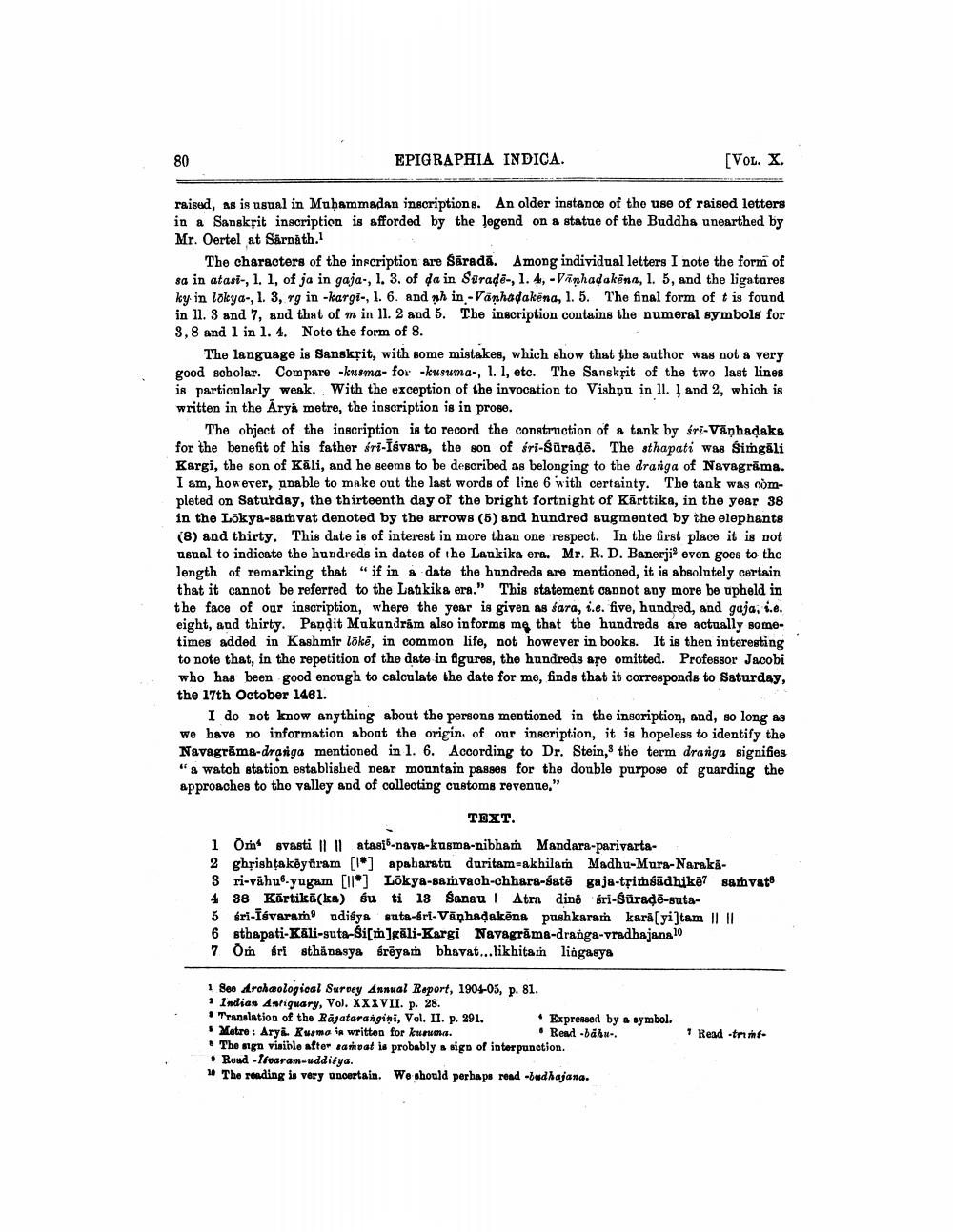________________
80
EPIGRAPHIA INDICA.
[VOL. X.
raised, as is usual in Muḥammadan inscriptions. An older instance of the use of raised letters in a Sanskrit inscription is afforded by the legend on a statue of the Buddha unearthed by Mr. Oertel at Särnäth.1
The characters of the inscription are Sarada. Among individual letters I note the form of sa in atasi-, 1. 1, of ja in gaja-, 1. 3. of da in Surade-, 1. 4, -Vanhadakēna, 1. 5, and the ligatures ky in lökya-, 1. 3, rg in -kargi-, 1. 6. and nh in-Vanhadakena, 1. 5. The final form of t is found in 11. 3 and 7, and that of m in 11. 2 and 5. The inscription contains the numeral symbols for 3,8 and 1 in 1. 4. Note the form of 8.
The language is Sanskrit, with some mistakes, which show that the author was not a very good scholar. Compare -kusma- for -kusuma-, 1. 1, etc. The Sanskrit of the two last lines is particularly weak. With the exception of the invocation to Vishnu in ll. Į and 2, which is written in the Arya metre, the inscription is in prose.
The object of the inscription is to record the construction of a tank by śri-Vaṇhaḍaka for the benefit of his father śri-Isvara, the son of fri-Süraḍe. The sthapati was Simgali Kargi, the son of Kali, and he seems to be described as belonging to the dranga of Navagrama. I am, however, unable to make out the last words of line 6 with certainty. The tank was completed on Saturday, the thirteenth day of the bright fortnight of Karttika, in the year 38 in the Lōkya-samvat denoted by the arrows (5) and hundred augmented by the elephants (8) and thirty. This date is of interest in more than one respect. In the first place it is not usual to indicate the hundreds in dates of the Laukika era. Mr. R. D. Banerji2 even goes to the length of remarking that "if in a date the hundreds are mentioned, it is absolutely certain that it cannot be referred to the Latikika era." This statement cannot any more be upheld in the face of our inscription, where the year is given as sara, i.e. five, hundred, and gaja, i.e. eight, and thirty. Pandit Mukundram also informs me that the hundreds are actually sometimes added in Kashmir lõke, in common life, not however in books. It is then interesting to note that, in the repetition of the date in figures, the hundreds are omitted. Professor Jacobi who has been good enough to calculate the date for me, finds that it corresponds to Saturday, the 17th October 1481.
I do not know anything about the persons mentioned in the inscription, and, so long as we have no information about the origin of our inscription, it is hopeless to identify the Navagrama-dranga mentioned in 1. 6. According to Dr. Stein, the term dranga signifies "a watch station established near mountain passes for the double purpose of guarding the approaches to the valley and of collecting customs revenue."
TEXT.
1 Om svasti | atasi-nava-kusma-nibham Mandara-parivarta
2 ghrishṭakeyaram [*] apaharatu duritam-akhilam Madhu-Mura-Naraka
3 ri-vahu6-yugam [1] Lōkya-samvach-chhara-satē gaja-trimsadhikē samvats
4 38 Kārtikā (ka) su ti 13 Sanau Atra dine śri-Suraḍē-suta
5 śri-Isvaram adisya suta-sri-Vanhaḍakena pushkaram karā[yi]tam || ||
6 sthapati-Kali-suta-Si[m]gali-Kargi Navagrama-dranga-vradhajana 10
7 Om fri sthanasya éreyam bhavat...likhitam liagasya
1 See Archaeological Survey Annual Report, 1904-05, p. 81.
Indian Antiquary, Vol. XXXVII. p. 28.
Translation of the Rajatarangini, Vol. II. p. 291.
Expressed by a symbol. Read -bahu-.
Metre: Arya. Kusma is written for kusuma.
The sign visible after samvat is probably a sign of interpunction. Read -Ifearam-udditya.
10 The reading is very uncertain. We should perhaps read -budhajana.
7 Read -trim




